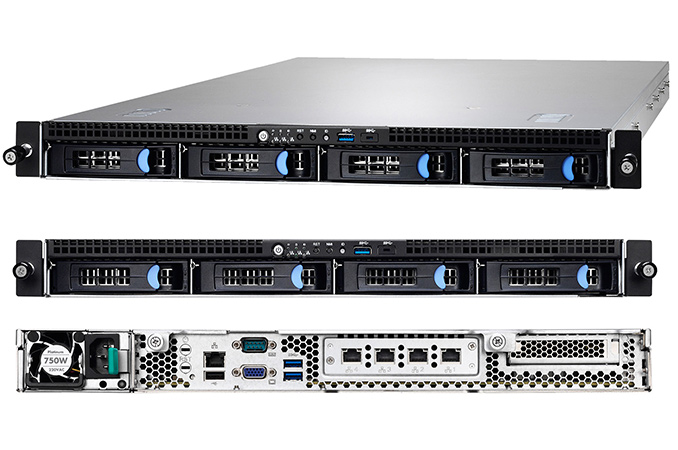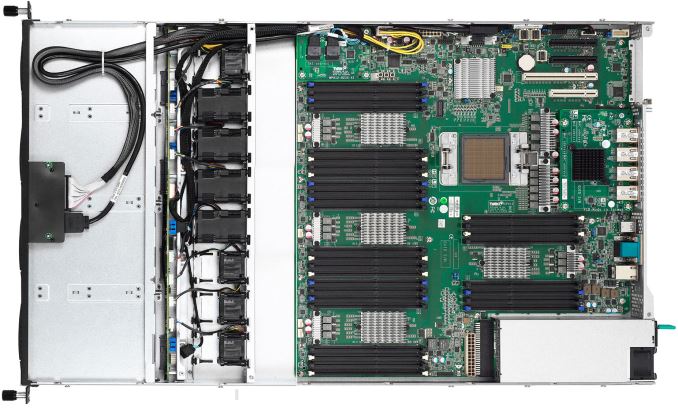Tyan Introduces 1U POWER8-Based Server for HPC, In-Memory Applications
by Anton Shilov on April 7, 2016 8:59 AM EST- Posted in
- IT Computing
- Enterprise
- IBM
- POWER
- Tyan
- POWER8

At this week's OpenPOWER Summit in San Jose, California, Tyan has introduced its new IBM POWER8-based 1U servers designed for high-performance computing (HPC) as well as in-memory applications. The new machines are designed to target niche markets that do not require extreme processing performance, but need a lot of RAM. The new Tyan GT75 expands the range of Tyan’s POWER8-based machines and helps IBM’s POWER8 platform to compete against Intel Xeon in niche markets.
Nowadays over 95% of servers are based on Intel’s Xeon microprocessors, which does not make producers of servers and operators of large datacenters happy because they have one supplier of key components that controls platform development and prices. Three years ago, IBM teamed up with Google, Mellanox, NVIDIA and Tyan to establish the OpenPOWER Foundation to develop servers based on IBM’s processors collaboratively. So far, IBM POWER-based servers have not gained a lot of market share, but it looks like they are starting to gain traction as companies like Tyan are expanding their POWER8 hardware offerings.
The Tyan GT75 machines (just like the Tyan TN71-BP012 servers launched a year ago) are based on one IBM POWER8 Turismo SCM processor with eight or ten cores and can be equipped with up to 1 TB of memory. The systems feature 32 R-DDR3L DIMM slots using four IBM Centaur memory buffer chips (MBCs) and support 32 GB modules, which are considerably more affordable than 64 GB or 128 GB memory sticks.
| Comparison of IBM POWER8 Turismo CPUs Compatible with Tyan's SC75 and TN71 Servers |
||||
| POWER8 8-Core | POWER8 10-Core | POWER8 12-Core | ||
| Core Count | 8 | 10 | 12 | |
| Threads | 64 | 80 | 96 | |
| Frequency (nominal) | 2.328 GHz 3.325 GHz |
2.095 GHz 2.926 GHz |
2.561 GHz | |
| L2 Cache | 512 KB per core 2 MB per CPU |
512 KB per core 5 MB per CPU |
512 KB per core 6 MB per CPU |
|
| L3 Cache | 8 MB eDRAM per core 64 MB per CPU |
8 MB eDRAM per core 80 MB per CPU |
8 MB eDRAM per core 96 MB per CPU |
|
| DRAM Interface | DDR3L-1600, memory connects to CPUs using the IBM Centaur MBCs | |||
| PCI Express | 3 × PCIe controllers, 32 lanes | |||
| TDP | 130W 190W |
130W 190W |
190W | |
While the GT75 servers (BSP012G75V4H) feature only one CPU, each IBM POWER8 core can process up to eight hardware threads simultaneously thanks to 16 execution pipelines. The chips also have massive caches (512 KB L2 per core, 8 MB eDRAM L3 per core as well as 16 MB per MBC), which are particularly useful for memory-intensive applications.
| Comparison of Tyan GT75 Servers | ||||
| BSP012G75V4H-B4C | BSP012G75V4H-Q4T | BSP012G75V4H-Q4F | ||
| CPU | IBM POWER8 8-Core 2.328 GHz 130 W/169 W TDP |
IBM POWER8 10-Core 2.095 GHz 130 W/169 W TDP |
IBM POWER8 10-Core 2.095 GHz 130 W/169 W TDP |
|
| Installed RAM | 8 × 16 GB R-DDR3L | 16 × 16 GB R-DDR3L | 32 × 16 GB R-DDR3L | |
| RAM (subsystem) | Up to 1 TB of DDR3L-1333 DRAM, 32 RDIMM modules, four IBM Centaur MBCs | |||
| Storage | 2 × 512 GB SSDs | 2 × 1 TB SSDs | 4 × 1 TB SSDs | |
| Tyan Storage Mezzanine | MP012-9235-4I (4-port SATA 6Gb/s IOC w/o RAID stack) |
|||
| LAN | 4 × GbE ports | 4 × 10 GbE ports | 4 × 10 GbE ports | |
| Tyan LAN Mezzanine | MP012-5719-4C Broadcom 1GbE LAN Mezz Card |
MP012-B840-4T Qlogic+Broadcom 10GbE LAN Mezz Card- |
MP012-Q840-4F Qlogic 10GbE LAN Mezz Card | |
The Tyan GT75-BP012, which is a 1U server that is designed for in-memory computing, HPC and virtualization, can be equipped with up to four 3.5” hot-swappable SAS 12G/SATA 6G HDD/SSDs, four network controllers (1 GbE and 10 GbE) as well as a 750 W PSU. The server uses the PLX PEX8748 PCIe switch and one PCIe 3.0 x8 expansion slot. Tyan did not reveal the price of the system, but said that it would be available already in April.
The new 1U machines complement the Tyan TN71-BP012 launched in March, 2015. The TN71 is a 1-way 2U platform for data analytics and applications, it supports 12 3.5” hot-swappable SAS 12G/SATA 6G HDD/SSDs, four 10 GbE network ports as well as two 1200 W PSUs for redundancy reason. This machine supports IBM POWER8 Turismo SCM processor with up to 12 cores and is generally more powerful than the GT75.
Source: Tyan











36 Comments
View All Comments
frenchy_2001 - Thursday, April 7, 2016 - link
Intel's implementation of SMT (Simultaneous Multi Threading), called by Intel hyperthreading, allows for 2 threads per core. IBM's implementation in POWER8 allows for 8 thread per core (as those are dedicated server CPUs).AMD will introduce their version of SMT with their next architecture, allowing also 2 threads/core.
F@st - Friday, April 8, 2016 - link
Thanks SlakeDK, name99, frenchy_2001.Kevin G - Thursday, April 7, 2016 - link
Interesting that only half of the memory channels are actually used. Though looking at the motherboard, they would have ran out of physical room to put another 32 DIMM slots.The other thing that stands out are the TDP and clock speeds. The clocks are far lower than other POWER8 systems. This drop in clock speed doesn't lower the TDP that much either.
name99 - Friday, April 8, 2016 - link
If the target market is primarily to move data from here to there and back, then lower frequency means cheaper CPUs, with no real effect on performance. (There are simulations that recommend CPUs save power by dropping frequency during stretches of code that are memory dominated,but I don't know if anyone implements this yet. Point is, the simulations show that the performance drop is minimal.)As for overall power, I'm guessing the CPU power is probably lost in the noise compared to the IO and DRAM power. The CPU power matters from the point of view of not wanting to overheat the CPU (and thereby destroy it), but probably not that much in terms of system power.
Bottom line is, I'm guessing this is a way for IBM to sell off lousy CPU binnings (low frequency and/or too much power/Hz) to a market that can get some value out of them. Which is ultimately a good thing for everyone :-)
Kevin G - Friday, April 8, 2016 - link
Energy consumption being dominated by DIMMs is likely true. Even low balling per DIMM power consumption at 5W per DIMM means that memory would be the largest energy consumer. Having 32 slots attached to a single socket is a lot of memory and that'd only half of what POWER8 can do.SlakeDK - Friday, April 8, 2016 - link
And also so IBM can differentiate with their Power8 servers :)